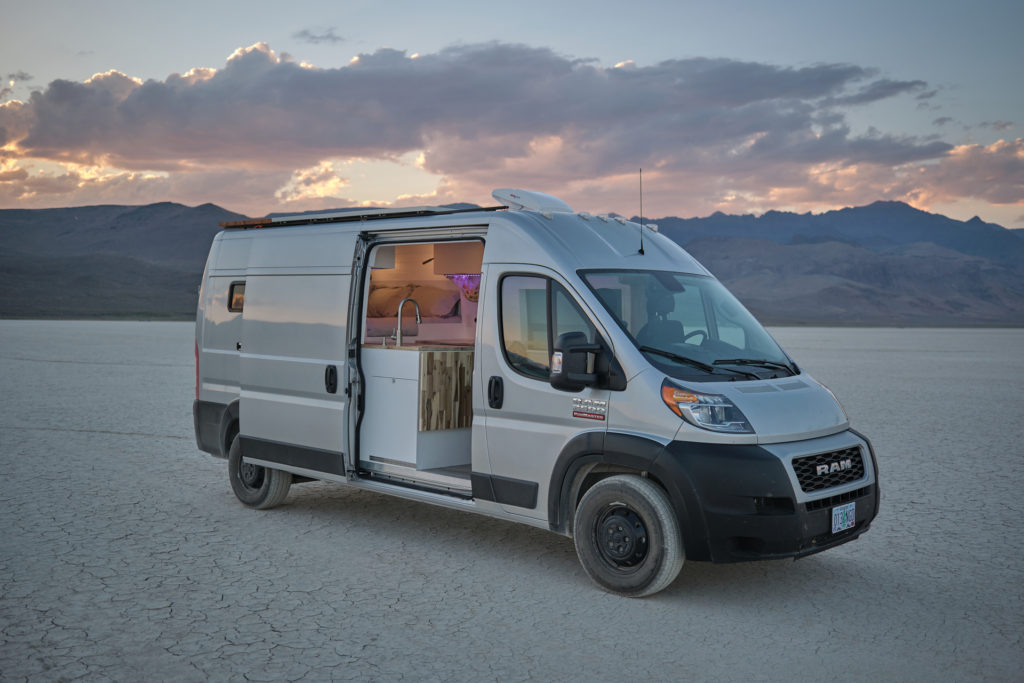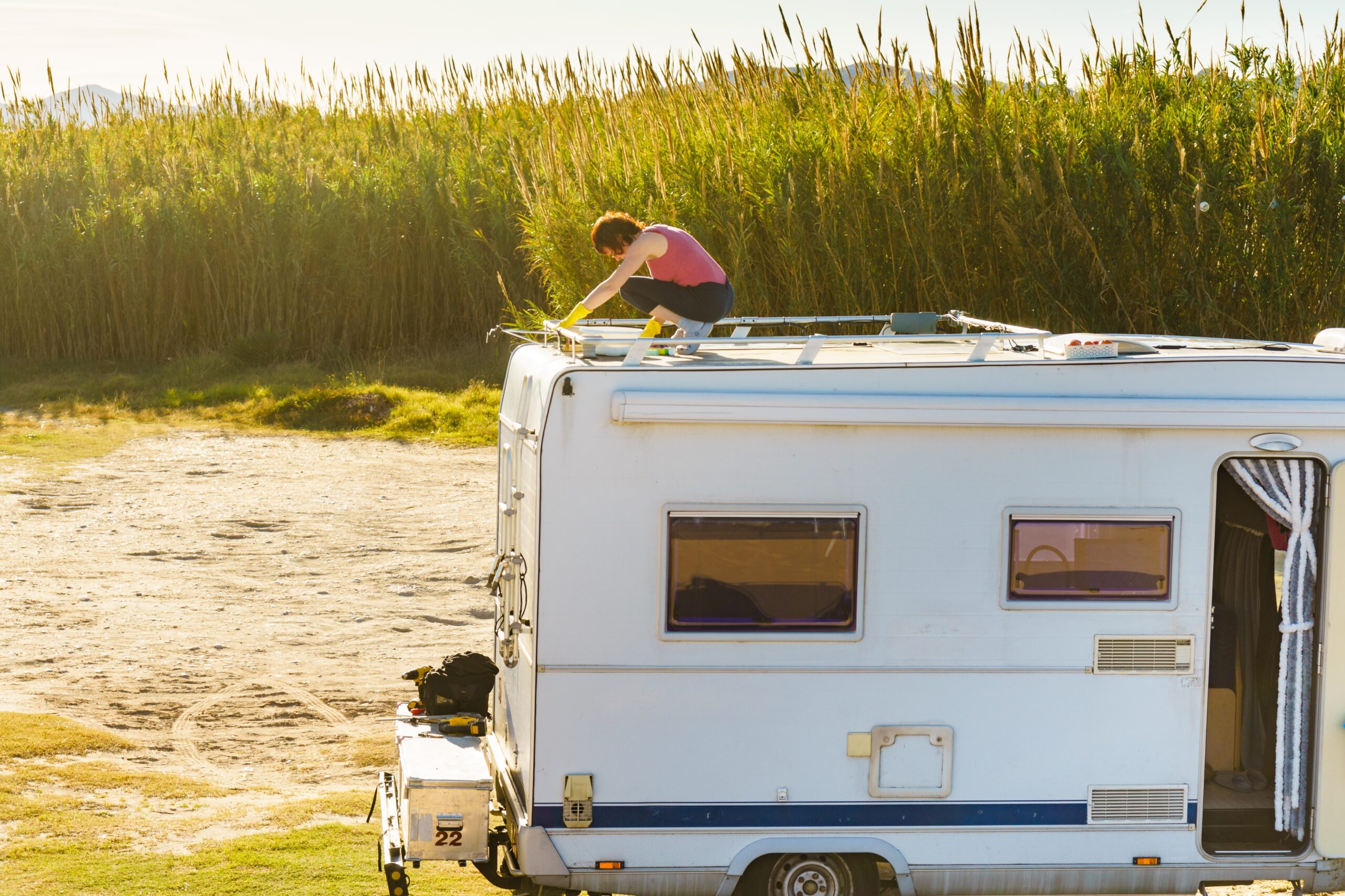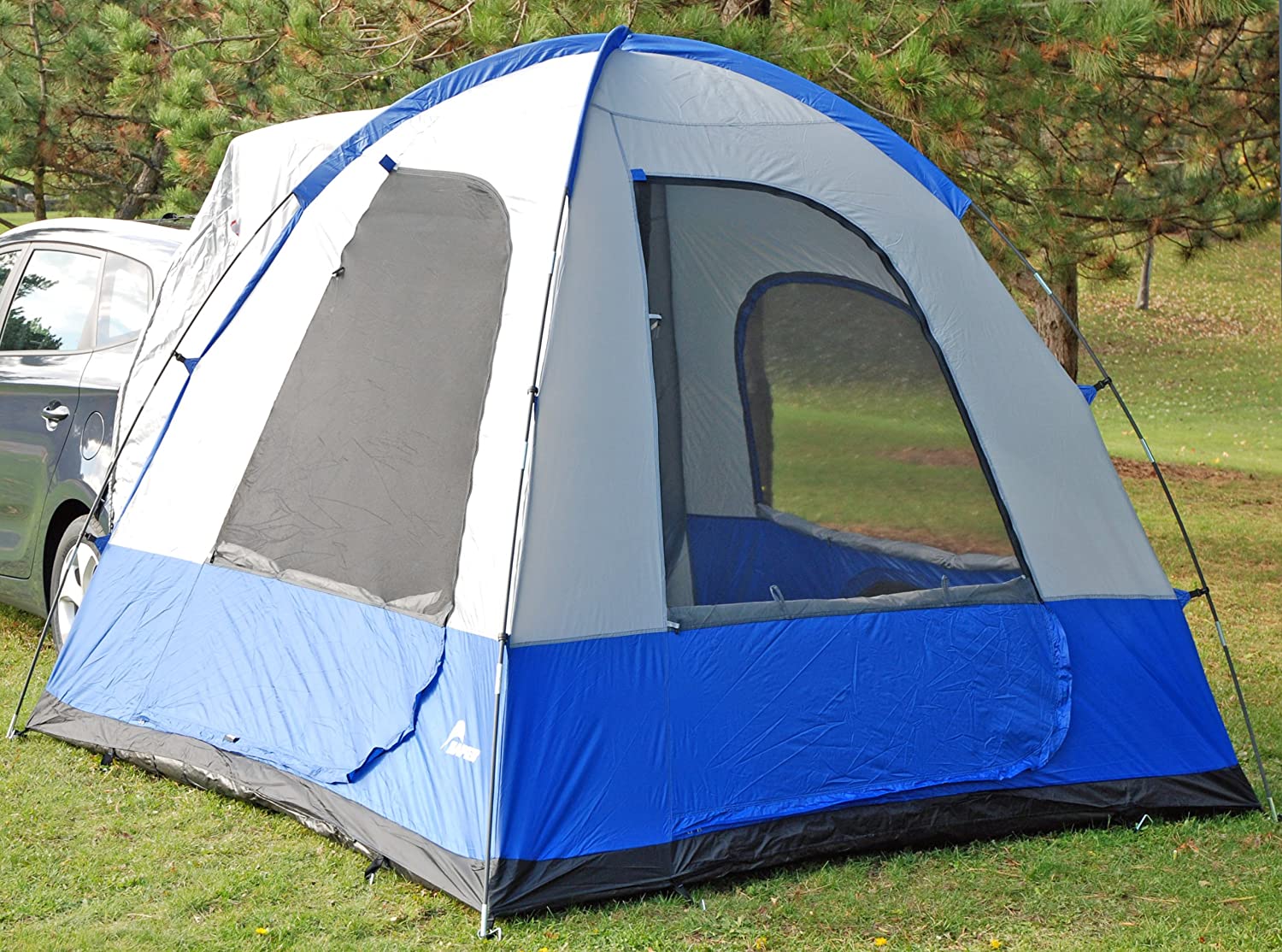
A Great Way to Outfit Your SUV for Tent Camping
If you love camping but just don’t have the money to dish out for an RV or van conversion, consider investing in an SUV tent to complement your Jeep, SUV, or minivan. SUV tents come in all sizes and designs and cost a fraction of what an RV is priced at, new or used.
They are intended to be used for every camping occasion, especially on overlanding excursions wherever your off-roading vehicle can go, for additional space and comfort on big family trips, and for overall protection from inclement weather.
However, it’s not enough to choose an SUV tent that accommodates your vehicle, crew, and camping specifications. Outfitting your SUV for camping mode completes the package for the ultimate outdoor experience for fun, convenience, comfort, versatility, and safety.
In this article, these two factors—SUV tents and camping gear—will be discussed and brought together to help transform your SUV into an all-in-one camper.
Types of SUV Tents
SUV tents can be attached to a vehicle via the rear door or rooftop and offer many features. The following are the two main types of SUV tents.
Hatchback Tent
Like the name implies, a hatchback tent attaches snugly to the rear door of sedans, SUVs, minivans, and Jeeps. Many manufacturers’ goal is to create universal hatchback tents, able to fit the widest range of vehicles possible, however, there are a few brands specific to a vehicle. In this case, it’s always a good rule of thumb to check product information for vehicle compatibility.
This SUV/tent combination doubles your living space and provides extra weatherproofing. Although SUV tents can be utilized as stand-alone tents, when attached to the SUV, campers can access their vehicle after entering the tent. You won’t have to step outside in bad weather if you want to collect gear or supplies from your vehicle. Everything can be housed in the combined camping structure for convenient retrieval and use.
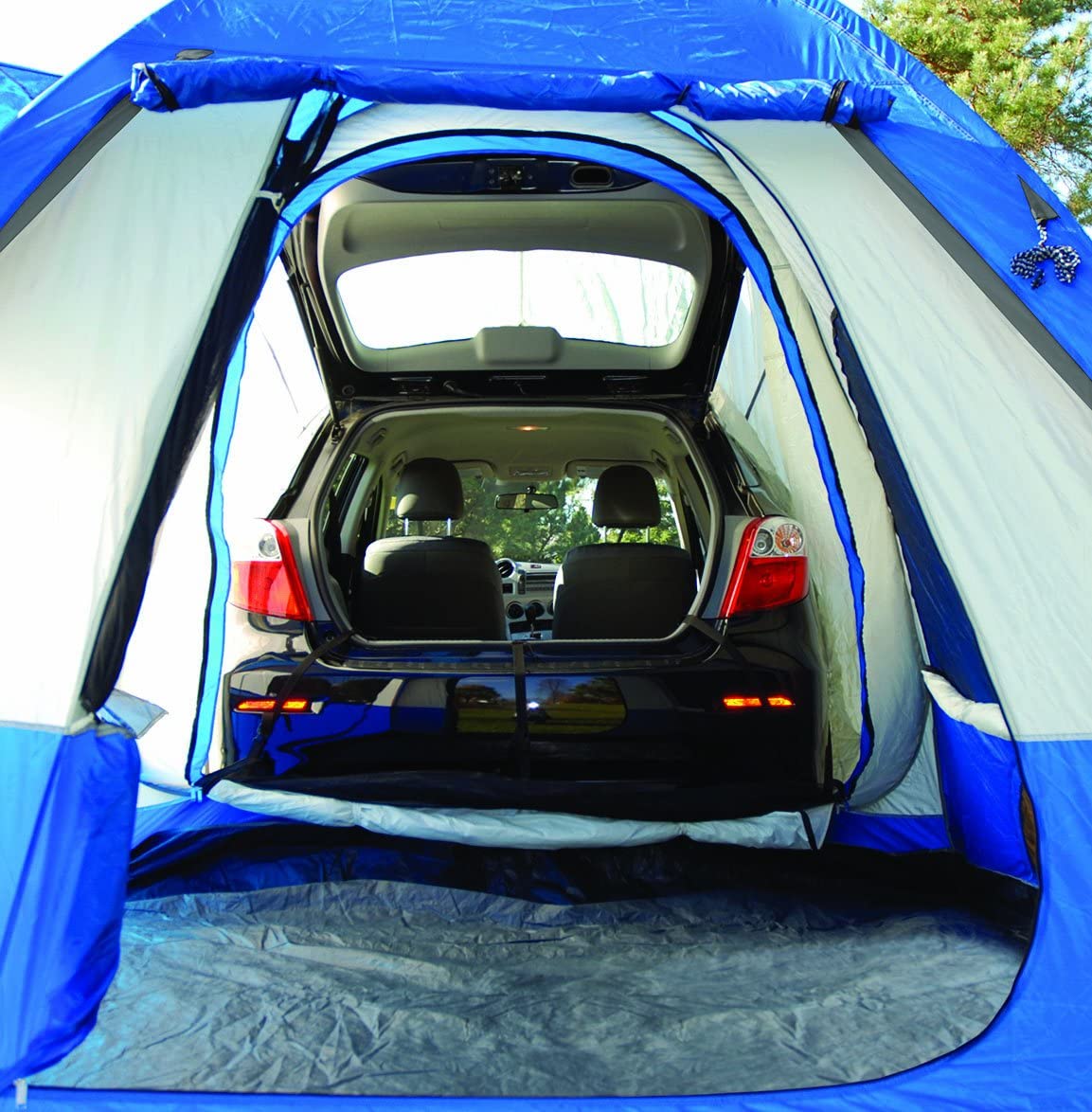
Floorplans
Hatchback tents are built to accommodate different needs. Multi-room tents can comfortably sleep five or more people, store outdoor gear, or provide additional shelter from the elements. SUV tents can be decked out with expandable tunnels, individual sleeping rooms, a screen room, and extendable awnings. If campers fold down the rear seats to make a bed in their SUV, the tent can be set up as another room, kitchen, or lounging area.
Besides a multi or single room tent, some campers may opt for an SUV awning. The same principles apply with setup, only this apparatus is more of a screen for the rear door. The awning provides shade from the sun, shelter from a downpour, and a barrier from bugs.
Protection and Safety
Good quality hatchback tents (really any type of SUV tent) excel in three design components: material, ventilation, and weatherproofing.
Material: Fabric like polyester and nylon blends are lightweight, easy to clean, waterproof, and tend to fare well outdoors. Tents with elastic bands help seal the unit around the back of the car. The flooring should be designed with a thick base to prevent rips. Fiberglass, steel, and aluminum all make for a sturdy framework, however, fiberglass would be the best choice since it is the least expensive of the bunch and doesn’t rust.
Ventilation: Not only do mesh screens keep pesky bugs out of the tent, but they also keep air moving, fresh air in and stale air out. The more mesh, the better ventilation.
Weatherproofing: Although most hatchback tents are waterproof, the degree of permeability differs. If you are looking for the best protection from rain, look for tents with a high waterproof rating. A rainfly is also ideal as it serves as an additional cover.
Setting up a Hatchback Tent
There are many variations of hatchback tents, but they all have one thing in common: how they fit on an SUV.
The video below, featuring the Napier Sportz SUV Tent with a Screen Room, demonstrates setting up a hatchback tent. Whereas some setups take a mere 3-5 minutes, depending on the size, parts, and camper experience, it can take longer.
Popular Hatchback Tents
Highly-rated: The Rightline Gear SUV Tent is a single room tent with an 8’ X 8’ floor area and 7.25’ height. Up to 4 adults can comfortably sleep in the space. It is made of water-resistant fabric and the floor is reinforced to prevent water from collecting under the tent.
The SUV tent has large windows and doors that can be opened and closed in the dark easily with the glow-in-the-dark zippers. The screens are made of a finer mesh that protects against tiny insects like no-see-ums, gnats, and sand flies.
The Rightline Gear’s adjustable sleeve makes it compatible with attaching it to both rear hatch doors and rear barn doors of any SUV, minivan, crossover, wagon, and Jeep hardtop.
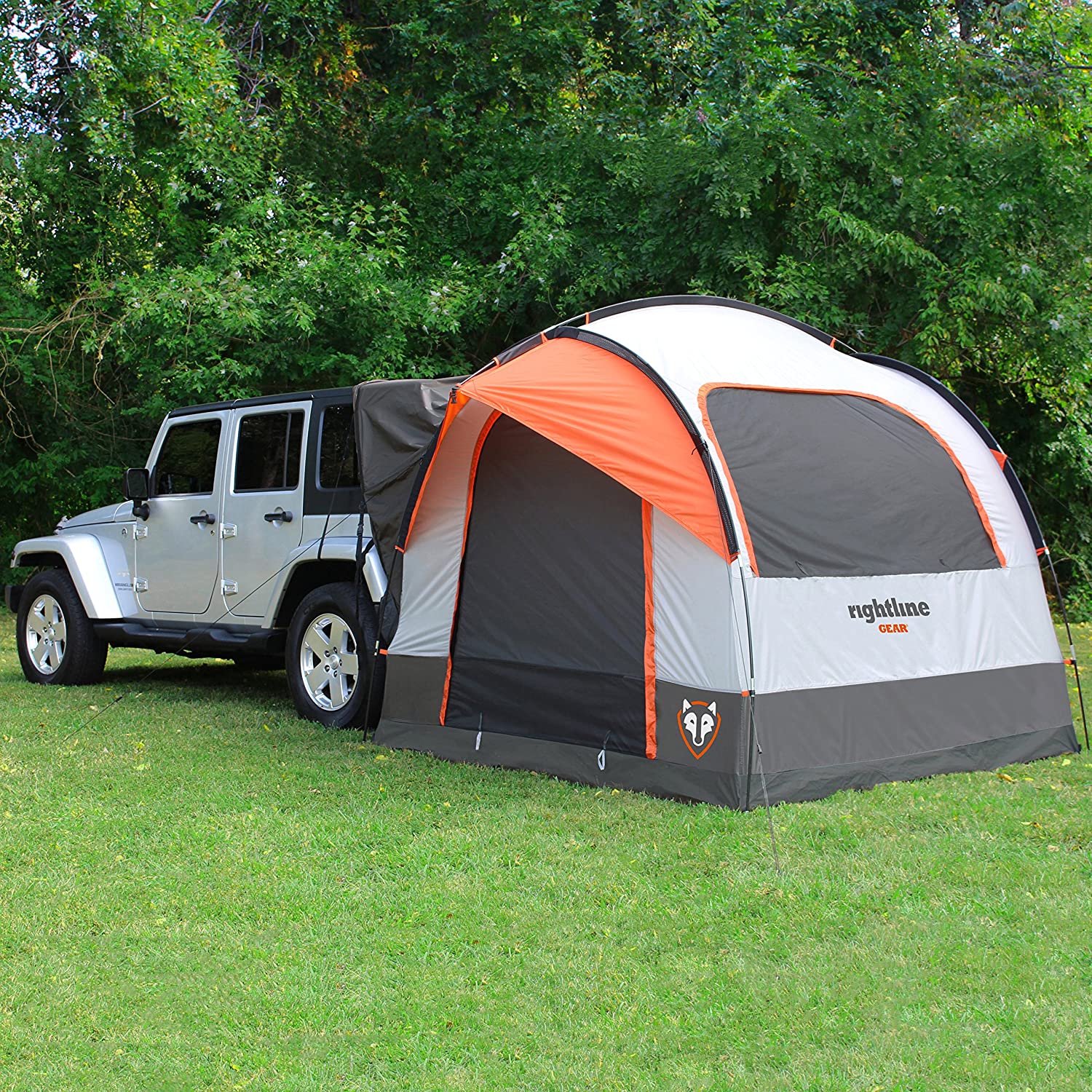
Easy Setup: The Mogic’s Carsule is a “pop-up cabin for your car.” Simply place the CARSULE pack on the ground and pop it up with support poles in about five minutes. The giant cube has about 6.5 feet of headroom and is advertised as a multifunctional space for your SUV.
It can be used as a bedroom, kitchen area, workspace, or lounge. The Carsule is designed specifically for hatchbacks. It is waterproof, UV-resistant, and is integrated with mosquito netting.
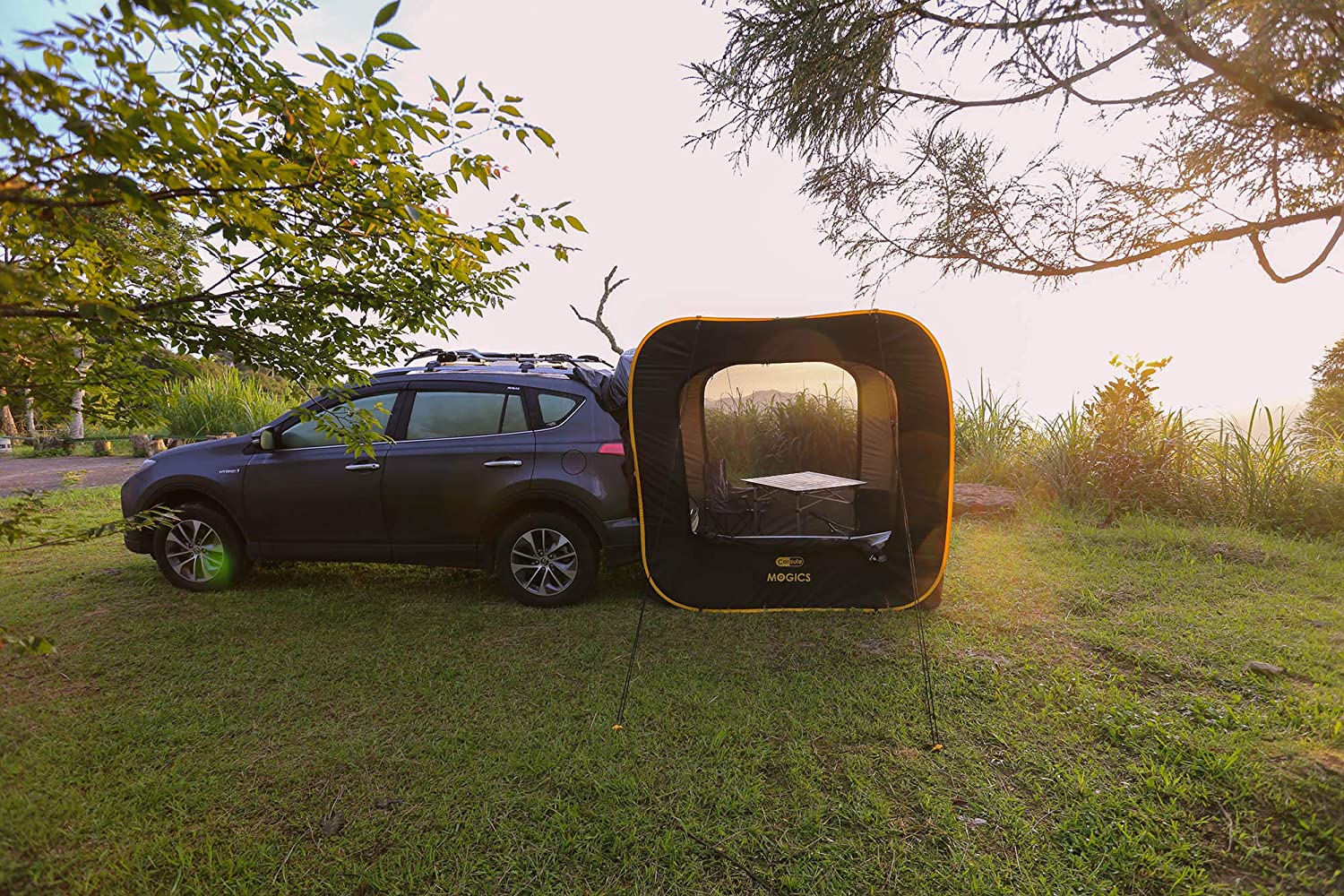
Rooftop Tent
Another type of SUV tent is a rooftop tent. This tent allows campers to set up camp anywhere. They can stay off the rocky or muddy ground and out of the way of any creepy crawlers or other wildlife.
The apparatus is secured to the roof rack and unfolded when ready to set up camp. A ladder allows occupants to climb in and out. There are many options to choose from when deciding on the best rooftop tent for you.
Structure and Build
Rooftop tents are classified as soft shells and hard shells. A softshell tent resembles a standard tent as it is primarily composed of a canvas-style roof and walls. Hard shells are heavier, but the hard portion, typically the roof of the tent, adds more protection during transport and bad weather.
Both styles are easy to unfold, but the hard shell by far is the quickest setup. Once unlatched, they can spring up like a jack-in-the-box. Just like the hatchback tents, good structural integrity, proper ventilation, and weatherproofing make up the components for high-quality shelters.
Consider these before getting a rooftop tent
Before jumping on the rooftop bandwagon, take a look at some of these upfront specifications and costs. For all the ways rooftop tents enhance our camping experience, in the end, they might not be the best fit for you.
- Rooftop tents are very popular, but they don’t work for everyone’s vehicle. These tents generally weigh over 100 pounds. With the addition of campers and supplies, there are just some roofs and factory racks that aren’t built with the structural capacity rated to carry this load. Always double check your vehicle’s weight class for rooftop limits. Sometimes the only fix needed is a stronger rooftop rack.
- Also, unlike hatchback tents that cost a few hundred dollars at most, rooftop tents can be quite pricey. Now you’re looking at thousand dollar items. Softshell tents cost around $1,000 to $2,000 and hard shells run from $2,000 to $5,000.
Set up a rooftop tent
The following video demonstrates how to unfold and set up a soft shell rooftop tent plus a ladder in a matter of 15 minutes.
An annex is also included in the clip. This is an optional addition to most rooftop tents. It’s a separate space that sits under the rooftop tent and is completely enclosed, allowing for a standing room to change clothes or shower and a shield from the weather as you enter and exit the side door of your SUV.
Popular Rooftop Tents
Soft Shell: The Nomadic 2 by Overland Vehicle Systems is a 4-season rated tent made from marine grade rip-stop polyester-cotton canvas and stainless steel hardware. It has a 350-pound capacity tubular ladder. The body and rainfly are waterproof.
The window screens keep the mosquitos out and the air flowing, plus there is a skylight for plenty of stargazing. The interior comes complete with an insulated base, 3” high-density foam mattress, and plenty of built-in storage pockets. The Nomadic 2 can sleep up to three people with a sleeping footprint of about 55” by 94”.
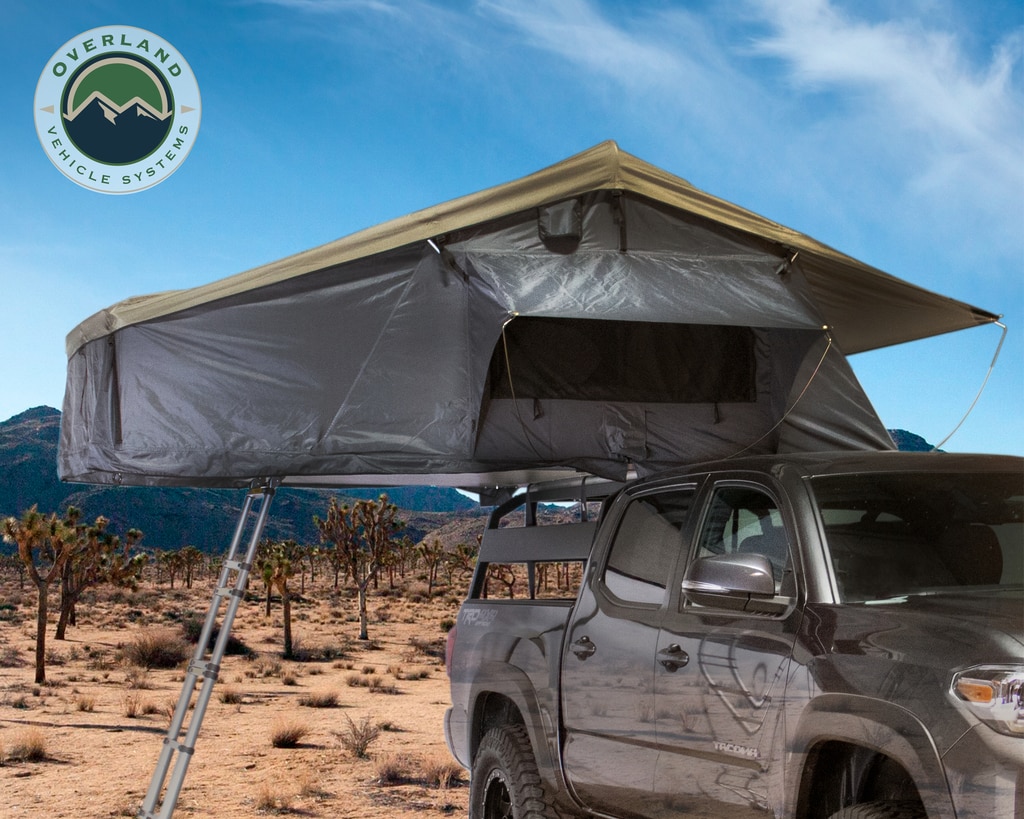
Hard Shell: The Smittybilt Hard Shell Tent is a low profile unit built with an aluminum frame. The waterproof tent sleeps anywhere from 2 to 3 people with a 55” by 85” sleeping footprint and has a 660-pound load capacity.
The telescoping ladder has a 300-pound limit. Setup and breakdown are a cinch with the gas-assisted struts when opening and closing the tent. All four sides of the tent have gusseted awnings over each window, and the interior includes a 2” thick high-density foam mattress and an LED lantern.
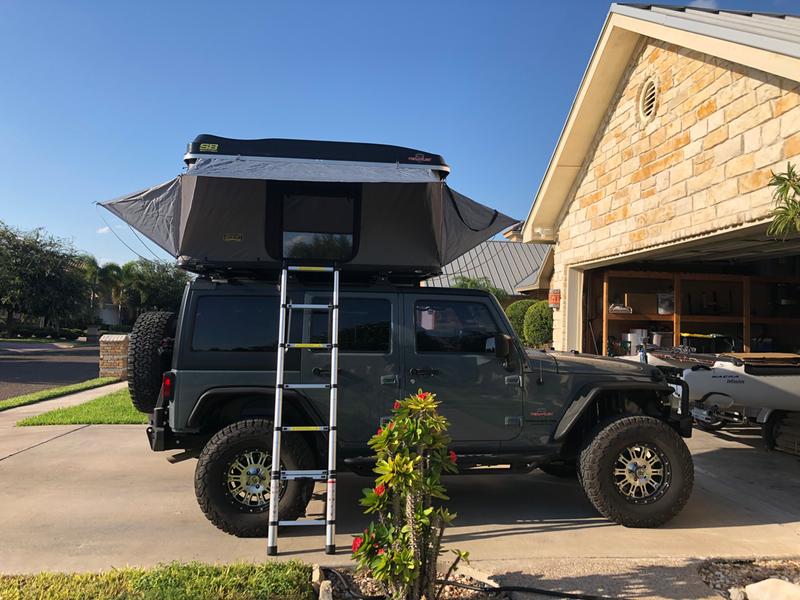
Outfitting your SUV for camping
With the two main types of SUV tents in mind, it’s time to combine your choice of shelter with camping must-haves to complete your all-in-one SUV camper.
This involves determining a layout to organize and store your camping equipment. Plus, it includes bringing along some sort of power source, especially if you like to bring along your smart devices and other electronics.
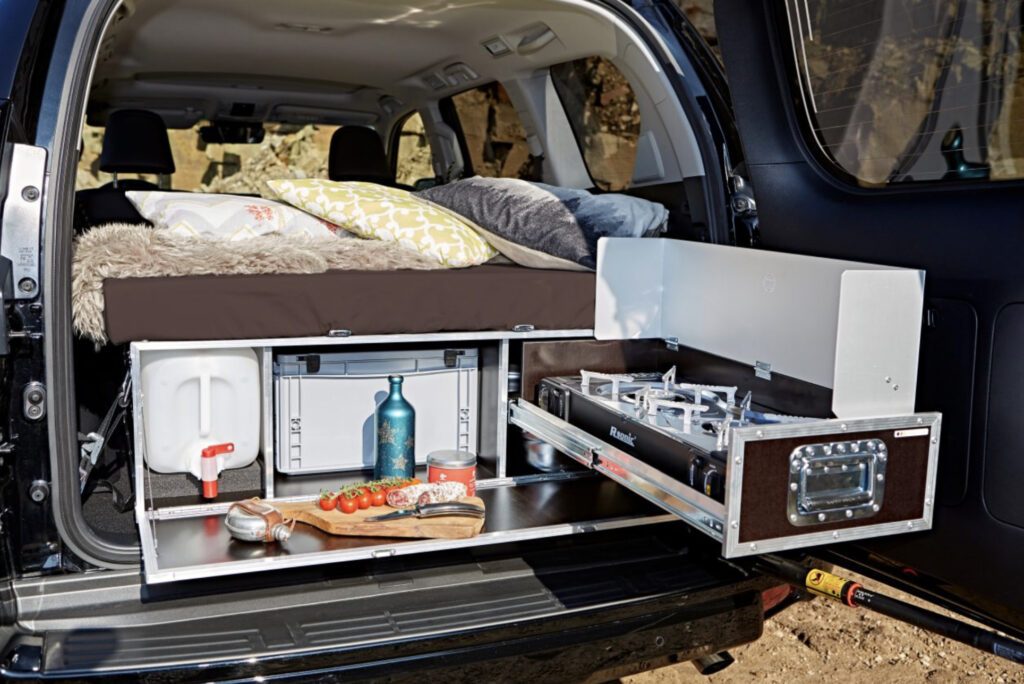
The Layout
How an SUV is organized for camping mode will differ from person to person. Still, in general, every camping trip involves sleeping, eating, some sort of outdoor venture, and cleaning. Regardless of what is brought, the task is how to lay out the items needed for each camping activity.
Sleeping area
Sleeping arrangements are determined by the number of people coming along for the camping trip. With a hatchback tent, bedding can be set up in the vehicle and the tent itself. The more rooms, the more folks can join. Similarly, with the rooftop tent, campers can sleep on top and inside the SUV.
At a minimum, a sleeping bag will suffice for bedding, maybe throw in a sleeping pad. Many SUV owners that convert their SUVs to campers (whether it’s for a weekend getaway or cross country road trip) will install some sort of platform, usually constructed out of wood, in the back of their vehicle. The rear seats are either removed or folded down to create room for this platform and a full-size memory foam mattress. The platform also allows space underneath to store additional camping gear.
Galley
The kitchen area can be as simple as erecting a folding table and laying out an ice chest. Of course, there is always a more convenient way to set up a table. At least that’s what Sam Gross of the Nomad Kitchen Company thought before creating his clever in-house galley.
“Setting up and taking down before and after each meal was alright, but it was a hassle,” Gross said. “It took up time that I would have rather been hiking or enjoying time with friends. My trunk was a constant mess, and I never felt like my dishes were as clean as I’d have liked. As an engineer, I knew there was a better solution.”
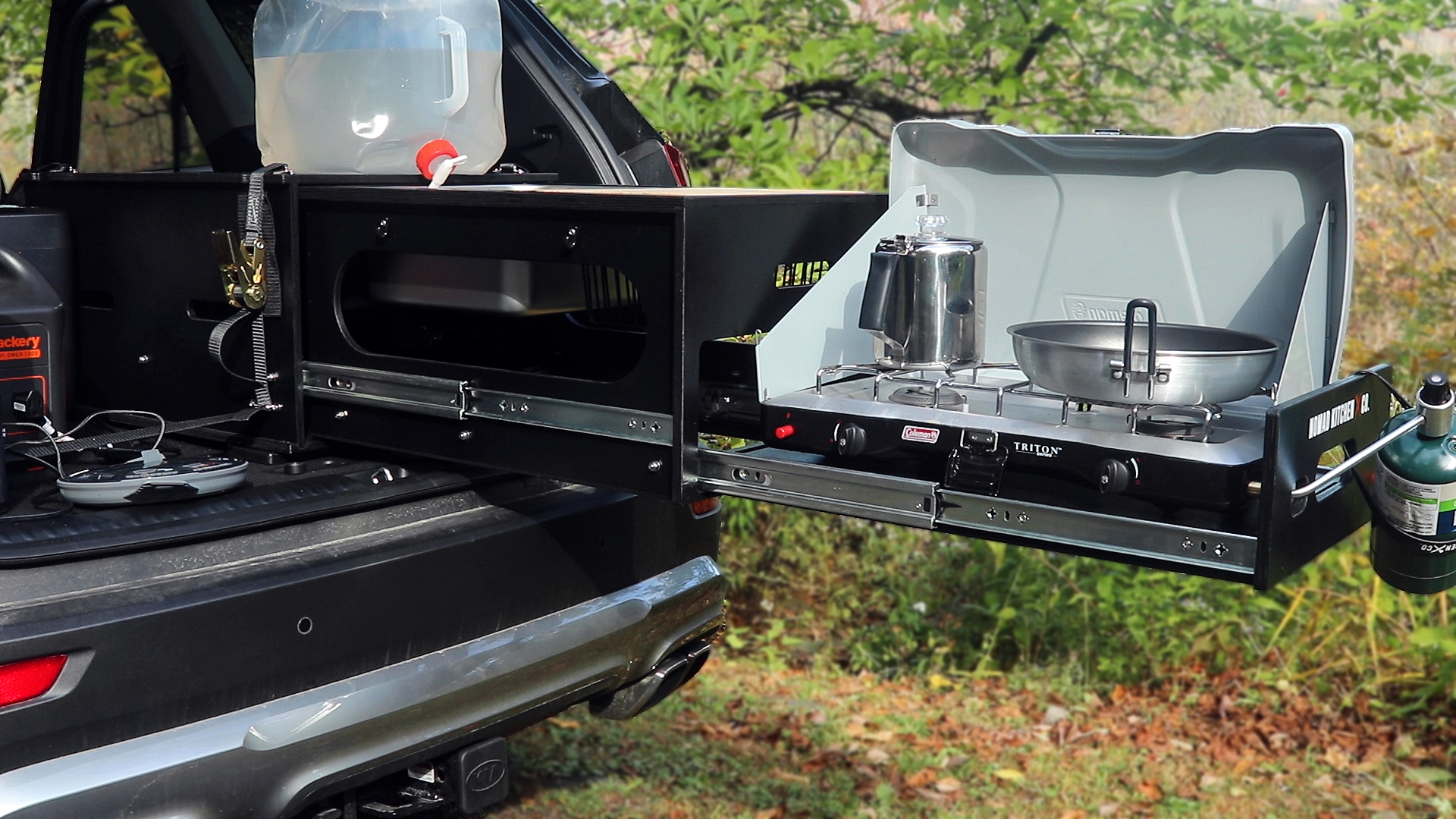
The Nomad Kitchen is a small kitchen kit that takes up little space. It slides out of a storage box and can easily be mounted into an SUV, with no tools required. The setup includes:
- A stainless-steel washbasin for a spigot-compatible water jug.
- A cutting board.
- A drying rack/storage bin.
- A platform for a two-burner stove with a strap to support a propane bottle.
Shower
Whether it’s washing dishes after a meal, washing your hands, or taking a shower to rinse off after a dip in the lake, campers have some kind of water storage.
Water can be collected by twisting a nozzle to open the container’s spigot. Some camper conversion gurus have set up a shower system on their SUV roof and use a portable water pump and heater for a more relaxing shower.
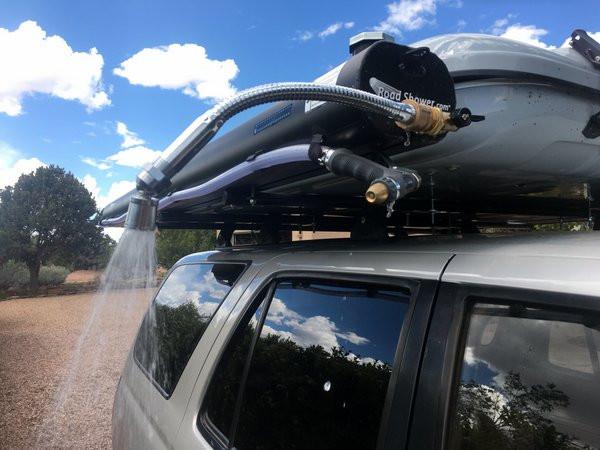
Storage options
Finding the space to pack all that camping fun seems to be an ongoing struggle for many folks. The addition of an SUV tent, hatchback or rooftop, allows for many different storage options, in transport and at the campsite.
If someone opts for a hatchback tent, not only is there room inside the SUV for items, but they can install a rooftop cargo carrier. A rooftop tent eliminates the need to set up a bed inside the SUV, thus opening more room for other equipment. Outdoor gear like bikes can be mounted to the back of SUVs while driving to and from the destination.
Power source
Of course, what’s a modern-day camping trip without freshly brewed coffee from the coffee maker, milk from a portable fridge or cooler, and using an app to map out your route on your charged smartphone?
If you like roughing it to a degree, then bringing along a portable power station like a Jackery lithium-ion power station might be more of a need than a want for your outdoor adventure.

Unlike those noisy, fume-filled gas generators, portable power stations like the Jackery Explorer 1000 are quiet, emit no harmful fumes, and can be powered using your SUV carport or 100 w solar panels.
The article “Jackery Portable Power Station: Product Review” is an honest review by a full-time RVer and camping enthusiast. He lays out how to set up and operate the portable power station so you can determine if this brand or type of power source is something that will upgrade your camping trip.
SUV Camper Conversion Tour
After a solid month, Christian Giannotti, a photographer from New York, finished his Jeep Wrangler camper conversion. He refers to his new and improved SUV as “car camping on steroids” and takes viewers on a tour of his custom build including a full bed, kitchen, and outdoor shower.
He writes, “For me, this was the most practical way to get into #vanlife without actually owning a van. I hope you find some inspiration to do something similar. You don’t need a van. You don’t need a Jeep. It just takes the confidence and determination! Time to go Jeep camping!”
Test out your new SUV tent and camping gear
A quality SUV tent coupled with camping essentials can make outdoor excursions an enjoyable experience. Once you’ve set up your SUV for camping mode, there’s only one more thing left to do: figure out where to go!
For RV-safe routes to any camping destination, use the online planning tool RV LIFE Trip Wizard. Plus, read reviews on different campsites on RV LIFE Campgrounds to narrow down your options and find the best stop for you and your traveling crew in your decked-out SUV camper.
See also: The Dirty Truth Of SUV Camping

